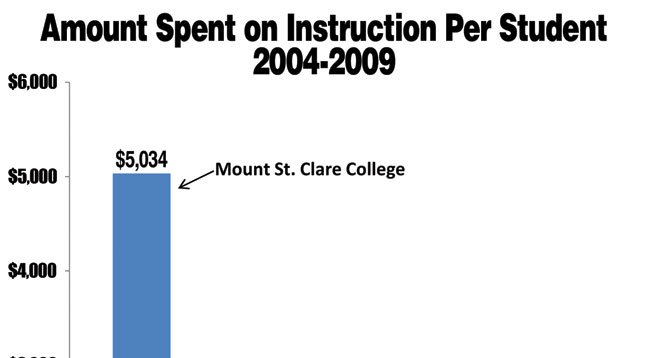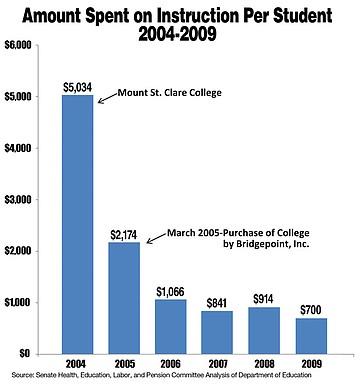 Facebook
Facebook
 X
X
 Instagram
Instagram
 TikTok
TikTok
 Youtube
Youtube

Education and Wall Street are diametrically opposed. Education focuses on the broad horizon over long periods of time. Wall Street slobbers over the fast buck and scoffs at societal values.
But a funny thing is happening. Wall Street is beginning to realize that America’s leadership is wising up to the $35 billion, highly profitable but pedagogically deficient for-profit college industry. Formerly high-flying stocks of for-profit colleges have dropped this year; San Diego’s Bridgepoint Education, two-thirds owned by a Wall Street firm, has receded from a high of $26.94 to $20.34 on Monday.
Red flags are everywhere. Student loans have hit $1 trillion — a sum exceeding credit card debt. Student loans may be the next credit bubble threatening the economy. Feelings are so strong on college campuses that President Obama has taken to the hustings, battling to persuade Congress to keep interest rates on some student loans from doubling on July 1, when a jump is scheduled to take place. Late last month, Obama signed an order protecting military personnel from deceptive recruiting by for-profit colleges. Bridgepoint recruits heavily on military bases.
A stunning 92 percent of students at for-profit institutions take out loans, compared to 28 percent at public colleges, according to the Department of Education. The average tuition at a for-profit school is six times higher than at a community college and twice as high as at a four-year school, according to the United States Senate Committee on Health, Education, Labor, and Pensions. For-profit colleges account for 10 percent of college students but almost 50 percent of loan defaults, says the Department of Education. And rarely can student-loan debt be wiped out through bankruptcy.
As the citizenry gets alarmed, politicians are responding. Democratic senators Tom Harkin of Iowa and Kay Hagan of North Carolina last month introduced a bill that would prohibit colleges from using federal taxpayer money for marketing and promotion. These for-profits get 85 to 90 percent of their revenues from federal government sources such as Pell grants. And the schools use about one-fourth of their budgets on advertising, marketing, and recruiting — generally, high-pressure telephone sales targeting people who really don’t qualify for a college education. Your tax money is paying for ballyhoo.
The Department of Education has tried several times to introduce reforms, only to be thwarted by heavy industry lobbying of Congress. Last year, the department was working on plans that would penalize for-profit institutions whose graduates did not fare well in the job market. But when the regulations came out June 2, they were emasculated, much to the joy of Wall Street. Stocks of two for-profit colleges soared 20 percent that day. Bridgepoint shares jumped 3 percent both June 2 and June 3.
Politics on the issue are hypocritical. Democrats, who generally favor the underprivileged — main targets of for-profit recruiters — are the reformers, led by Harkin. Republicans, self-proclaimed watchdogs of the public purse, applaud the for-profits although they get almost all their funding from the federal government.
In March of last year, Harkin’s committee held a special hearing on Bridgepoint abuses. Data were taken from the Department of Education and Bridgepoint’s own filings with the Securities and Exchange Commission. In 2010, profit accounted for 30.3 percent of Bridgepoint revenue. Marketing was 29.7 percent (a good deal higher than the industry’s high average). The remaining 40 percent was spent on faculty salaries, executive compensation, administration, student services, and — finally — actual instruction.

In 2005, seeking to get accreditation, Bridgepoint bought a tiny, financially ailing college in Iowa, Franciscan University of the Prairies (formerly Mount St. Clare College). In 2004, this school had spent $5034 per student on instruction. By 2009, under Bridgepoint, that number was down to $700 per student. By contrast, in 2009, the University of Iowa was spending $12,000 a year per student on education. Bridgepoint was spending three times more on recruiting students than educating them.
Now, 99 percent of Bridgepoint students go to school online, and Kathleen Tighe, inspector general of the Department of Education, told Harkin’s committee last year that her investigators, who had been doing an audit for several years, question whether people who claim to be online students actually are.
By 2010, almost two-thirds of students in the 2008–2009 Bridgepoint bachelor’s degree programs had dropped out; a stunning 84.4 percent of students in the associate’s (two-year) program had withdrawn.
Tighe’s inspectors found that Bridgepoint disbursed federal aid to ineligible students. Under the law, after students drop out, the school should return certain student-aid funds to the Department of Education or the lender. But, testified Tighe, Bridgepoint did not accurately calculate the funds it should return and then didn’t return them in a timely manner.
The audit, which was completed in January of last year, also concluded that Bridgepoint’s recruiters were, in effect, paid for the numbers of students they wooed into the fold. This had been banned in 1992, with certain exceptions, but Bridgepoint did not qualify for those exceptions.
It’s little wonder that Senator Harkin calls Bridgepoint “a scam, an absolute scam.” Several states also have the company under investigation. But it’s lobbying hard — as of July 2011, it was on the education task force of the highly controversial American Legislative Exchange Council.
On March 7 of this year, Bridgepoint submitted its annual report to the Securities and Exchange Commission. It listed the offenses that Department of Education investigators had found and then admitted that if it failed to change its ways, it could suffer monetary penalties or even lose its access to federal money. If it couldn’t suck on the government teat, the company would die.
Bridgepoint has put similar warnings in previous annual reports to the government, but Wall Street always overlooked them, figuring that lobbyists’ power would make sure that this industry could continue to pick taxpayers’ pockets. However, that may change in the new environment.


Education and Wall Street are diametrically opposed. Education focuses on the broad horizon over long periods of time. Wall Street slobbers over the fast buck and scoffs at societal values.
But a funny thing is happening. Wall Street is beginning to realize that America’s leadership is wising up to the $35 billion, highly profitable but pedagogically deficient for-profit college industry. Formerly high-flying stocks of for-profit colleges have dropped this year; San Diego’s Bridgepoint Education, two-thirds owned by a Wall Street firm, has receded from a high of $26.94 to $20.34 on Monday.
Red flags are everywhere. Student loans have hit $1 trillion — a sum exceeding credit card debt. Student loans may be the next credit bubble threatening the economy. Feelings are so strong on college campuses that President Obama has taken to the hustings, battling to persuade Congress to keep interest rates on some student loans from doubling on July 1, when a jump is scheduled to take place. Late last month, Obama signed an order protecting military personnel from deceptive recruiting by for-profit colleges. Bridgepoint recruits heavily on military bases.
A stunning 92 percent of students at for-profit institutions take out loans, compared to 28 percent at public colleges, according to the Department of Education. The average tuition at a for-profit school is six times higher than at a community college and twice as high as at a four-year school, according to the United States Senate Committee on Health, Education, Labor, and Pensions. For-profit colleges account for 10 percent of college students but almost 50 percent of loan defaults, says the Department of Education. And rarely can student-loan debt be wiped out through bankruptcy.
As the citizenry gets alarmed, politicians are responding. Democratic senators Tom Harkin of Iowa and Kay Hagan of North Carolina last month introduced a bill that would prohibit colleges from using federal taxpayer money for marketing and promotion. These for-profits get 85 to 90 percent of their revenues from federal government sources such as Pell grants. And the schools use about one-fourth of their budgets on advertising, marketing, and recruiting — generally, high-pressure telephone sales targeting people who really don’t qualify for a college education. Your tax money is paying for ballyhoo.
The Department of Education has tried several times to introduce reforms, only to be thwarted by heavy industry lobbying of Congress. Last year, the department was working on plans that would penalize for-profit institutions whose graduates did not fare well in the job market. But when the regulations came out June 2, they were emasculated, much to the joy of Wall Street. Stocks of two for-profit colleges soared 20 percent that day. Bridgepoint shares jumped 3 percent both June 2 and June 3.
Politics on the issue are hypocritical. Democrats, who generally favor the underprivileged — main targets of for-profit recruiters — are the reformers, led by Harkin. Republicans, self-proclaimed watchdogs of the public purse, applaud the for-profits although they get almost all their funding from the federal government.
In March of last year, Harkin’s committee held a special hearing on Bridgepoint abuses. Data were taken from the Department of Education and Bridgepoint’s own filings with the Securities and Exchange Commission. In 2010, profit accounted for 30.3 percent of Bridgepoint revenue. Marketing was 29.7 percent (a good deal higher than the industry’s high average). The remaining 40 percent was spent on faculty salaries, executive compensation, administration, student services, and — finally — actual instruction.

In 2005, seeking to get accreditation, Bridgepoint bought a tiny, financially ailing college in Iowa, Franciscan University of the Prairies (formerly Mount St. Clare College). In 2004, this school had spent $5034 per student on instruction. By 2009, under Bridgepoint, that number was down to $700 per student. By contrast, in 2009, the University of Iowa was spending $12,000 a year per student on education. Bridgepoint was spending three times more on recruiting students than educating them.
Now, 99 percent of Bridgepoint students go to school online, and Kathleen Tighe, inspector general of the Department of Education, told Harkin’s committee last year that her investigators, who had been doing an audit for several years, question whether people who claim to be online students actually are.
By 2010, almost two-thirds of students in the 2008–2009 Bridgepoint bachelor’s degree programs had dropped out; a stunning 84.4 percent of students in the associate’s (two-year) program had withdrawn.
Tighe’s inspectors found that Bridgepoint disbursed federal aid to ineligible students. Under the law, after students drop out, the school should return certain student-aid funds to the Department of Education or the lender. But, testified Tighe, Bridgepoint did not accurately calculate the funds it should return and then didn’t return them in a timely manner.
The audit, which was completed in January of last year, also concluded that Bridgepoint’s recruiters were, in effect, paid for the numbers of students they wooed into the fold. This had been banned in 1992, with certain exceptions, but Bridgepoint did not qualify for those exceptions.
It’s little wonder that Senator Harkin calls Bridgepoint “a scam, an absolute scam.” Several states also have the company under investigation. But it’s lobbying hard — as of July 2011, it was on the education task force of the highly controversial American Legislative Exchange Council.
On March 7 of this year, Bridgepoint submitted its annual report to the Securities and Exchange Commission. It listed the offenses that Department of Education investigators had found and then admitted that if it failed to change its ways, it could suffer monetary penalties or even lose its access to federal money. If it couldn’t suck on the government teat, the company would die.
Bridgepoint has put similar warnings in previous annual reports to the government, but Wall Street always overlooked them, figuring that lobbyists’ power would make sure that this industry could continue to pick taxpayers’ pockets. However, that may change in the new environment.
Comments